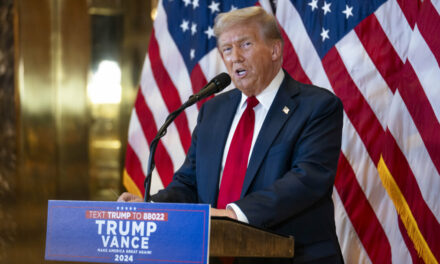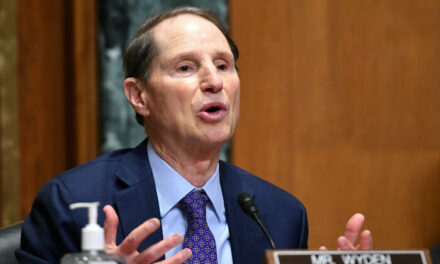We support our Publishers and Content Creators. You can view this story on their website by CLICKING HERE.
The justices asked questions about the meaning of the underlying federal law and how they should distinguish between firearms and their components.
The Supreme Court heard oral arguments on Oct. 8 over the Bureau of Alcohol, Tobacco, Firearms, and Explosives’ (ATF) attempt to apply federal gun control legislation in a way that would prohibit so-called “ghost guns.”
“Ghost guns” are generally understood to be untraceable firearms that lack serial numbers, were purchased by someone without a background check, and are potentially provided by a source other than someone licensed to do so.
The conservative justices raised questions about how to view a firearm’s components versus its entirety. Justice Amy Coney Barrett, considered more of a swing vote on the court, suggested that the attorney challenging ATF’s regulation was proposing a “made up” legal test.
In 2022, President Joe Biden’s administration attempted to crack down on ghost guns by implementing an ATF rule that interprets a longstanding federal law—the Gun Control Act (GCA) of 1968—as applicable to certain weapons kits, as well as items used to produce frames and receivers.
The Justice Department is asking the Supreme Court to reverse a U.S. Fifth Circuit ruling in Garland v. VanDerStok, which stated that ATF’s rule was inconsistent with the law.
Components of Firearms
Justice Samuel Alito questioned the idea that a gun’s components could be considered a gun before construction or conversion into a weapon. He asked U.S. Solicitor General Elizabeth Prelogar, for example, whether a pen and pad of paper could be considered a grocery list or whether the ingredients for an omelet could be considered an omelet itself.
Prelogar countered by suggesting those were not apt comparisons since those items were known to be used for other purposes.
Barrett questioned whether the situation would change if someone ordered omelet ingredients from Hello Fresh, a company that provides ingredients for cooking a particular item. Prelogar said that was a more apt comparison.
Justice Neil Gorsuch then told Prelogar that “we can’t possibly think that every noun that Congress uses everywhere in the U.S. code is used as an artifact noun that carries with it things like” those included in Justice Alito’s grocery list example.
Prelogar told Gorsuch that the justices could interpret the law based on an ordinary meaning, suggesting that they didn’t need to follow a highly specific or technical interpretation of terms in the statute.
Justice Sonia Sotomayor pressed Peter Patterson, an attorney for the respondents, on how to determine when gun components can be regulated. She suggested that he conceded a key point on this issue by noting that some kind of legal test was necessary for determining whether components could be regulated.
Barrett told Patterson that his proposed test for determining whether regulation was lawful seemed “a little made up” and that it wasn’t mentioned in the relevant statute.
Legal History
Sotomayor said past agency letters had similar language to what ATF used more recently.
“ATF has always looked at whether [the gun] reached a critical stage of manufacture,” Prelogar told Sotomayor.
Justice Clarence Thomas questioned Prelogar about her claim that this issue encountered regulation for years. “It wasn’t regulated in this way for half a century,” Thomas said.
Prelogar agreed that the ATF’s approach was a change to prior practice but defended the new rule, stating that the agency consistently focused on how quickly an individual could make a frame or receiver operational.
Justices Barrett and Gorsuch both questioned the meaning of the statute in relation to its history.
Barrett, for example, asked Prelogar to confirm that at the time of the law’s passage in 1968, people tended not to buy machine guns or grenades whole and purchased components due to regulations.
The Biden administration’s rule redefines firearms to include weapons parts kits that “may readily be converted, assembled, restored, or otherwise converted to expel a projectile by the action of an explosive.”
Alito asked Prelogar multiple questions, including whether weapons kits were common at the time of the statute’s passage. He also asked about the term “readily convertible” and the level of expertise, among other things, that was taken into account when considering when the law applies.
Prelogar said “readily convertible” should be interpreted based on how long a “novice” would take to convert certain items. Patterson said he worried that an expansive definition of “readily converted” could “wreak havoc” with firearms laws.
Justice Brett Kavanaugh told Prelogar that her statutory interpretation had “some force” but that he worried about mens rea, or the idea that criminals are aware that they’re committing a crime.
Kavanaugh told Prelogar that ATF had broadened the statute in question and wondered what kind of “assurances” Prelogar could offer. Prelogar told Kavanaugh that the point of the agency was not to play a game of “gotcha” in prompting criminal prosecution.
Prelogar’s opening statement described the law’s objectives as keeping guns out of the hands of minors and criminals.
This is a breaking news story and will be updated.

 Conservative
Conservative  Search
Search Trending
Trending Current News
Current News 







